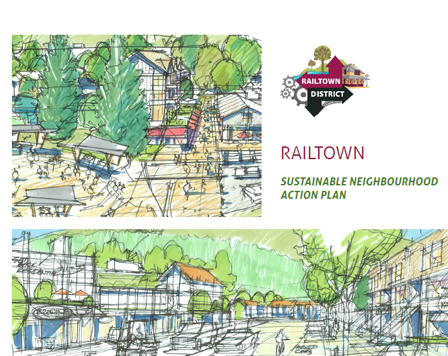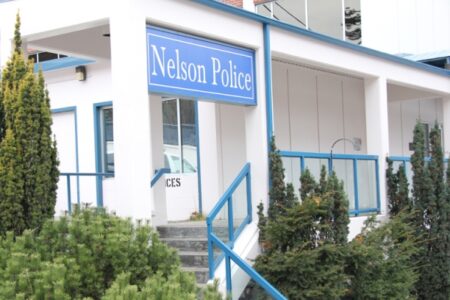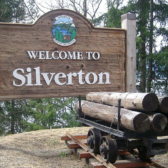Railtown neighbourhood plan steams into council chambers
The city is moving full steam ahead on its new community plan for Railtown.
On Monday city council accepted the first comprehensive and inclusive report on what could happen for the area of Nelson at the west end of Baker Street known as Railtown.
Called the Railtown Sustainable Neighbourhood Action Plan (SNAP), the plan is expected to form the framework for the creation of a mixture of residential, commercial and industrial, with better connections between Railtown and the downtown.
The plan was received very positively by city council, said Mayor Deb Kozak, but there is still some process before it gains adoption by the city.
“I think the plan has incorporated all of the good ideas we garnered from the community, all pulled together in a professional approach,” she said.
Counc. Val Warmington agreed.
“It’s still early days with respect to council’s review and assessment of the Railtown plan, but so far I’m impressed with how well it makes use of the available space to meet many of the city’s goals for healthy, livable, sustainable, well-connected, mixed used neighbourhoods,” she said.
“Preliminary work has been done to assess the feasibility of the plan with good results and we anticipate considerable interest from developers in the opportunities the plan envisions.”
The 28-acre Railtown neighbourhood has been planned based on a 35-year build out, with approximately 140 units anticipated in Railtown over the next 10 years, along with the potential for approximately 25,000 square feet of new commercial space and 11 acres of new light industrial space (city wide).
“In 2050, Railtown will be a thriving, dynamic and inclusive neighbourhood with an eclectic mix of local businesses and jobs to support community creativity and entrepreneurship,” noted the report, written by Modus Planning, Design and Engagement Inc. “A connected, quirky and lively public realm will support inclusivity, art, ecology and community celebration.”
The one unifying feeling at city hall is the Railtown SNAP is key to attracting new development and investment in Railtown, and is expected to contribute to a “strong, vibrant downtown core, and establishing better connections to the waterfront and the downtown as well as within the community.”
As it was a committee-of-the-whole meeting, no decisions were made on the report. The report will be coming back to a future council business meeting for approval and direction with respect to next steps.
“The plan is feasible; everything is, with money,” Kozak said. “There is nothing here that cannot be achieved over time through good partnerships and persistence.”
Eight “big moves” were indentified in the report to transform Railtown. They are expected to be a set of catalyst projects and public investments that, together, are the seeds that will initiate the transformation of Railtown.
The first is to connect Railtown and Baker Street to the waterfront, followed by the enhancement of the gateway to Railtown.
A connection will then be made from Baker Street to the Cottonwood Market, with a pedestrian mews/lane and a Baker Street connection.
The rail yard plaza near the Nelson and District Chamber of Commerce is located will be enhanced, and a station park will be created, with an area in Cottonwood Park designated as a mixed-use, multi-family zone.
The public realm and open space projects aim to support a connected active transportation network, including the connection of Baker Street with Government Road. Creating a transit connection through Railtown is also a priority.
The plan also has provision for additional parks and open spaces, with the possible addition of the former CP Rail Station’s superintendent residence on Baker Street to the city’s inventory.
“The city will be researching grants, building partnerships with business, CP Rail (and others),” said Kozak. “And we will be considering infrastructure development in our upcoming budget deliberations.”
Preparing the ground
One of the greatest challenges to realizing the vision for Railtown will be creating the right conditions for implementation success. The environment needs to facilitate action by three essential implementation partners: residents and community organizations; the business community; and government.
For its part, the city needs to enable and encourage business and resident activity through policy and regulatory changes, coordination and investment in capital projects as well as programs.
“While the Railtown Sustainable Neighbourhood Action Plan identifies public realm projects, it is not intended to be implemented only by the city,” the report read.
“Success will depend on close coordination between city departments and other partners to harness the full potential of Railtown.”
The idea of incentives to encourage developer interest has been mentioned but council has not yet discussed this possibility further,” said Warmington.
“For now, attention will focus on planning for the infrastructure installations and upgrades needed in advance of moving the plan forward in other ways,” she said.
The first phase of the project uses a low-cost approach to extend and link current interest, work and activity in the Rail Yard, Heritage Commercial and Market precincts and create momentum near Cottonwood Creek.
“This will enhance revenue streams for the city and other landowners, help establish the value of the area, and make development in the industrial and Live-Work precincts more attractive,” the report noted.
The first action by the city needs to be the removal of policy and regulatory barriers to change, and coordinating action by all partners, followed by encouraging action through incentives, working with partners to facilitate their participation.
Creating an incentive to development
It was recommended the city should explore the development of a revitalization tax exemption program that will not only encourage development in Railtown, but will encourage it to be done in an innovative and sustainable manner.
A list of eligible criteria needs to be established in order to achieve th exemptions.
The rail yard precinct around the Rail Station which houses the chamber of commerce includes seven key projects, including a kiosk and “parklet,” full restoration of the former freight shed, a flexible parking and events plaza, the revealing of Cottonwood Creek and a connection to the waterfront.
The work already done by the chamber to revitalize the CP Rail Station will help build the precinct, and spur development in the rest of the area.
“This project and the following proposed projects seed investment and build interest in the neighbourhood — and help to re-imagine Railtown as a lively destination in Nelson,” the report wrote.
The first big move in that direction was a recommendation the city work with the owners of the historic home to purchase it for use as park space and for special programming, and as a place to create the waterfront connection.
The historic building could become home to recreational and cultural facilities, the report noted, or as identified by stakeholders could provide support to youth or other identified social needs within Nelson, or a mixture of both.
During the planning process, one of the most commonly expressed desires by stakeholders and attendees of the public open houses was to see a connection between Railtown and the waterfront multi-use trail. A pedestrian trail connection from this location has been a long-term goal for the city, and a pedestrian overpass would help resolve safety issues of people crossing the tracks at unplanned areas.
“Creating a pedestrian connection will require close collaboration between the City of Nelson and CP Rail to find a solution, and this discussion has already been started through the Railtown planning process,” the report noted.
With the Railtown plan now in hand, city council must go a few steps further and incorporate it into the Official Community Plan and other city policy and bylaw documents should be updated to reflect the long-term vision and goals identified.
City staff time will be required to update the relevant policy documents and city bylaws.
Investigation of development incentives and green infrastructure guidelines will also require staff time. Public infrastructure and public realm projects identified within the plan will be funded through the city’s capital budget process as funding permits.
The majority of development identified in the plan is on private land and will be market driven, but some staff time will also be required to develop city-owned sites.
Mixed-use residential
Integral to the successful redevelopment of Railtown is the introduction of mixed-use residential.
“This is a key objective … and is critical to augment Nelson’s limited housing supply,” the report stated. “Many stakeholders expressed the desire to see housing in Railtown.”
Existing buildings within Railtown should be explored for adaptive reuse for residential, retail and live-work opportunities.
A number of city-owned sites in the area could be controlled to begin this development, the report wrote.
“The city plays an important role in the redevelopment of these sites, as they will likely act as a catalyst for the re-development of other sites within Railtown into mixed-use residential,” the report read.
The market analysis suggests that Nelson could likely expect an additional 11 acres of new light industrial space demand over the next 10 years. The area near Cottonwood and Government Road would be an ideal location to attract light industrial and office users that would fit well with retail and residential neighbours, the report suggested.
Getting to here
Development of the Railtown SNAP has included a number of sessions with the Railtown stakeholder team, the technical team, one-on-one meetings with Railtown landowners and business owners, as well as open houses. In addition, public feedback surveys and a project webpage were created to provide opportunities for public input and feedback to the Railtown SNAP.
Over 200 responses were received. The top priorities identified by the community for Railtown, in order of number of responses received, included:
- mixed-use development, multifamily, live/work, commercial, industrial (97 responses);
- multi-use path from Railtown to the waterfront (88 responses);
- extend the pathway along creek from Baker Street to Cottonwood Park (71 responses);
- create better pedestrian connections, sidewalks, overall pedestrian experience (56 responses);
- affordable housing (36 responses);
- restore native vegetation and fish and wildlife habitat in Cott onwood Creek (34);
- create green space and open space that is inviting and engaging for all ages (33).
On July 13 a petition was received that included 140 signatures that were in opposition to mixed-use residential being built on the city-owned Cottonwood Market site. However, 71 per cent (99) of these signatures were from individuals residing outside of Nelson.
The development of the Railtown SNAP was jointly funded by the City of Nelson (development services budget) and the Federation of Canadian Municipalities (FCM).
Capitalizing on key policy documents
Specifically, the SNAP plan is expected to achieve the goals identified in the key policy documents by:
- supporting anticipated market demand for new jobs;
- providing better physical and visual connections to the downtown, the waterfront and adjacent neighbourhoods;
- providing brownfield and ecological restoration;
- providing mixed use and innovative live work residential/commercial opportunities;
- creating a walkable, livable, compact community that is more sustainable environmentally, socially, and financially; and,
- adding to Nelson’s vitality, vibrancy and economic resiliency.



























